|
|
|
tools at the ready
Saturday, May 24 2008
The human toolkit consists mainly of ten fingers distributed between two hands, each attached to two thrice-jointed arms, each roughly two feet in length. Additionally, there are stereoscopic eyes each of roughly megapixel resolution, stereophonic ears with a range of 20-20,000 Hz, a mouth with chemical identification and wire stripping functionality, and a nose with further chemical-sensing properties. All materials of the human toolkit have a narrow temperature tolerance, ranging from about zero to fifty degrees Celsius.
In my normal life, my human toolkit is sufficient for opening jars, attending to issues of hygiene, flushing toilets, driving cars, opening letters, pushing lawn mowers, lifting objects, feeding myself, simulating the experience of sexual intercourse, and manipulating keyboards and computer mice. But I ask more of myself than my normal toolkit can provide. Consequently, I always like to keep a set of inorganic tools handy for the many occasions that require them. The most essential tool of all is a pair of needle-nosed pliers, the kind that comes with wire cutters. I use these for picking up small objects, bending metal, loosening nuts, breaking off small pieces of hard materials, cutting wire and other thin materials, plucking hairs, ticks, and porcupine quills, and holding materials that are too hot to be held in the fingers. After needle-nosed pliers, the most useful tools are, in decreasing order of necessity: a flathead screwdriver, a phillips screwdriver, an adjustable crescent wrench, a bastard file, and vise grips. I like to keep some subset of this tool list always at the ready, changing up the specific tools depending on the location. For example, in a kitchen drawer is a pair of needle-nosed pliers, scissors, a crescent wrench, two flathead screwdrivers, a phillips screwdriver, and (strangely) a rasp. In the boiler room is a set of ten different screwdrivers, a file, a crescent wrench, a drill-powered pump, two sizes of diagonal cutters, vise grips, a close-quarters pipe cutter, and a multimeter. There's a small set of tools in the woodshed, mostly related to cutting wood and maintaining woodcutting tools: a flat screwdriver, various wrenches (including two different adjustable crescent wrenches), an axe, a hatchet, a splitting maul, two different bow saws, an electric chainsaw, and three or four steel wedges.
Each car has a separate toolkit in the glove compartment. These include stripped-down metric socket sets (10, 12, 14, 17, and 19 mm), a crescent wrench, needle-nosed pliers, a flathead screwdriver, and a phillips. In the hatchback there's also a multimeter and a set of tiny screwdrivers, since it has traditionally served as my car. In the other car is an ice pick and a cell phone; make of that what you will.
The two main tool locations in the house are the shop and the laboratory, each of which have complete socket sets, fixed wrench sets, tin snips, hammers, cable tools, diagonal cutters, soldering tools, measuring tools, and nippers. As for power tools, they float freely to wherever they're needed, though all the big tools stay in the shop.
Over the years I've been trying to impose order on the various cluttered regions in my domain. Two years ago I focused on the shop, installing drywall, putting up shelves, and storing things. Last year the focus was the laboratory (which remains reasonably tidy to this day). Today I focused just for the day on the boiler room, whose tools have traditionally existed in a big chaotic pile. I built a system to organize and display the tools, getting them out of the way and making them easier to find next time I need them. This system ended up being a couple of shelves with some finishing nails to hang things on. Over the years I've wrestled with the best way to store screwdrivers. Should they be horizontal and intrude into the room or should they be vertical and occupy wallspace? I've come to realize that it all comes down to available space. For the boiler room's screwdrivers, I opted for horizontal storage, drilling a bunch of holes into the edge of a shelf into which I could poke them. This is also an ideal method for storing pens and pencils.
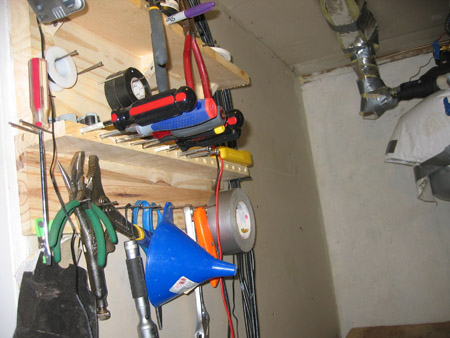
Boiler room storage.
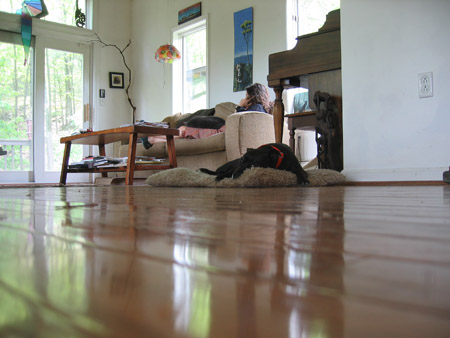
Gretchen with Wilma on her lap, talking on the phone in the living room. In the foreground is Eleanor.
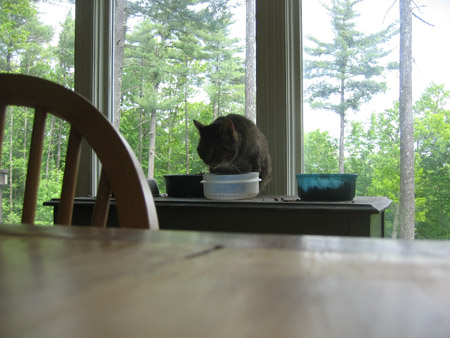
Marie (aka the Baby) eats on the catfood table in the dining room.
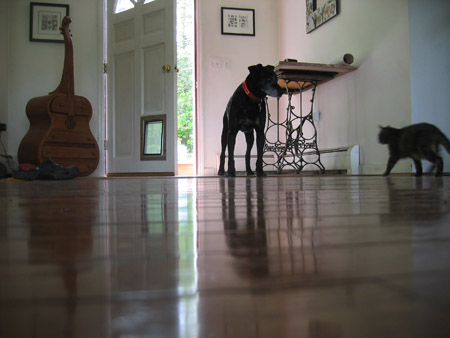
Sally and the Baby near the front door.
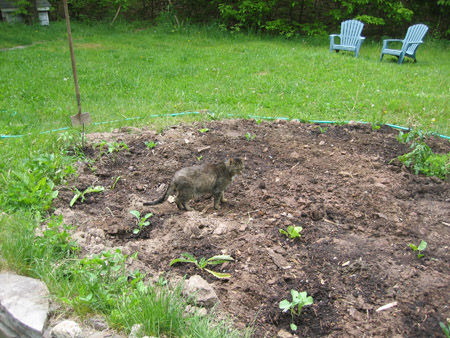
The Baby likes to use the garden for a litter box, though the dogs don't have the patience to wait for her shit to transform into tomatoes.
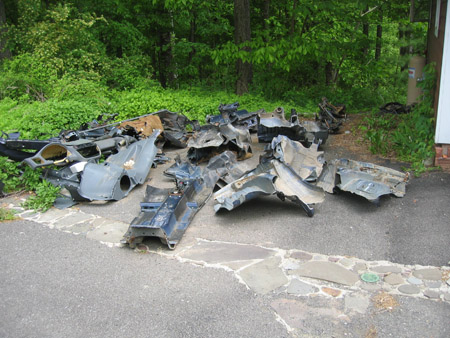
The parts of the stripped hatchback as of today.
For linking purposes this article's URL is:
http://asecular.com/blog.php?080524 feedback
previous | next |





